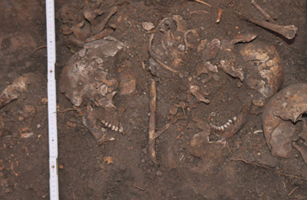
One day in 1941, Vasile Enache was tending his cows in the forest of Vulturi, near the city of Iasi, 260 miles northeast of Bucharest, when he heard people sobbing. He went to investigate and saw hundreds of civilians being marched through the forest by Romanian army soldiers. Enache didn’t know it at the time, but he was witnessing part of Romania’s “Iasi pogrom,” which resulted in the deaths of an estimated 14,000 Jews.
For almost 70 years, successive Romanian governments have downplayed the nation’s role in the Holocaust. But now a suspected mass grave has been found in the Vulturi forest, and some are hoping that the discovery will help Romania face up to one of the darkest periods in its history.
Rumors about a mass grave in the Vulturi forest had been circulating for years; when a similar grave was found near Iasi in 1945, it led to a trial that ended with several top military commanders being sentenced to jail. After persuading Enache to show him the exact location of the Vulturi grave, local historian Adrian Cioflinca organized a team of people from Romania’s Elie Wiesel National Institute for Studying the Holocaust to start excavating the site last month. They uncovered the remains of 16 bodies — including the skeletons of children, a lady’s shoe and Romanian-army bullets from 1939 — but have since called a halt to the dig while they wait for rabbis to bless the site.
Now 86, Enache is a bit wobbly on his legs, but his eyes are still clear blue, and his memory of what happened that day in 1941 is fresh. He describes how he was grabbed by a couple of Romanian soldiers who said, “You are a Jew! Come with us.” They arrived at a series of deep graves where the civilians were made to sit down, 10 at a time, and then shot. Others were ordered into the grave to arrange the bodies so more victims could be thrown in. The killings continued all day, but Enache managed to convince his captors that he was a local, an Orthodox Christian, and when this was confirmed by the local forester, he was released.